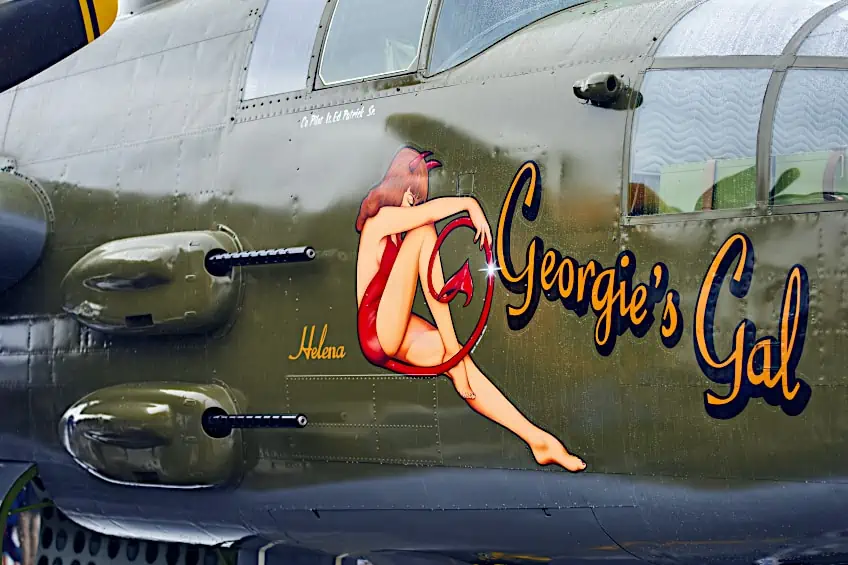WW2 Nose Art – The History of Military Aviation Art
You may have seen and heard about the many works of art produced during the war that references the activities and efforts of servicemen who dedicated their lives to World War II. You may be surprised to learn that the war produced its own art form called nose art or bomber artwork, by which air crew started customizing their aircraft with unique paintings for various reasons. In this article, we will guide you through the art form known as WW2 nose art, and review some of the most famous artists of this period, including some of the art form’s most prominent influences. Keep reading for more about this historical art form!
Contents
Aviation Art in World War Two
What is nose art, and what does it have to do with World War II? The genre of nose art refers to a historical art form that emerged in World War I and grew in popularity and style in World War II. The basis of nose art involved the decoration or customization of military aircraft with vibrant or personalized messages and images, which served different purposes and meanings for many pilots. In World War I, pilots from European forces painted their aircraft with images of intimidating animals, family insignia, and other symbols, which were recognizable and familiar touchstones for the forces during challenging times. This practice soon became a culture among air crews and took off in World War II.

Many crewmen of WW2 bomber planes and other aircraft models would commission artists to decorate their planes as a remembrance of their homes and the families they were fighting for. Nose art was a form of free artistic expression, reflecting a variety of tastes and preferences. Aviation art was incredibly significant for many reasons, which will be unpacked below. Nose art also included many iconic symbols and images that captured the popular references of the time and immortalized the artwork.
One can think of WW2 nose art as the only art form where its artwork traveled with its owner and was a part of the visual language of war, across the preparation, battle, and postwar period.
The iconic tradition went on to captivate members of various air-forces who continued to decorate their aircraft in bold colors, geometric patterns, stripes, and bright white circles, and transform the muted exterior of their planes into aircraft that displayed more than simply squadron identification. During the war, there were restrictions on the types of imagery one could paint, and certain protocols were implemented on risqué-styled artworks, however, crewmen would opt for water-soluble paints, which would be removed before their unique and bold expressions could be caught.
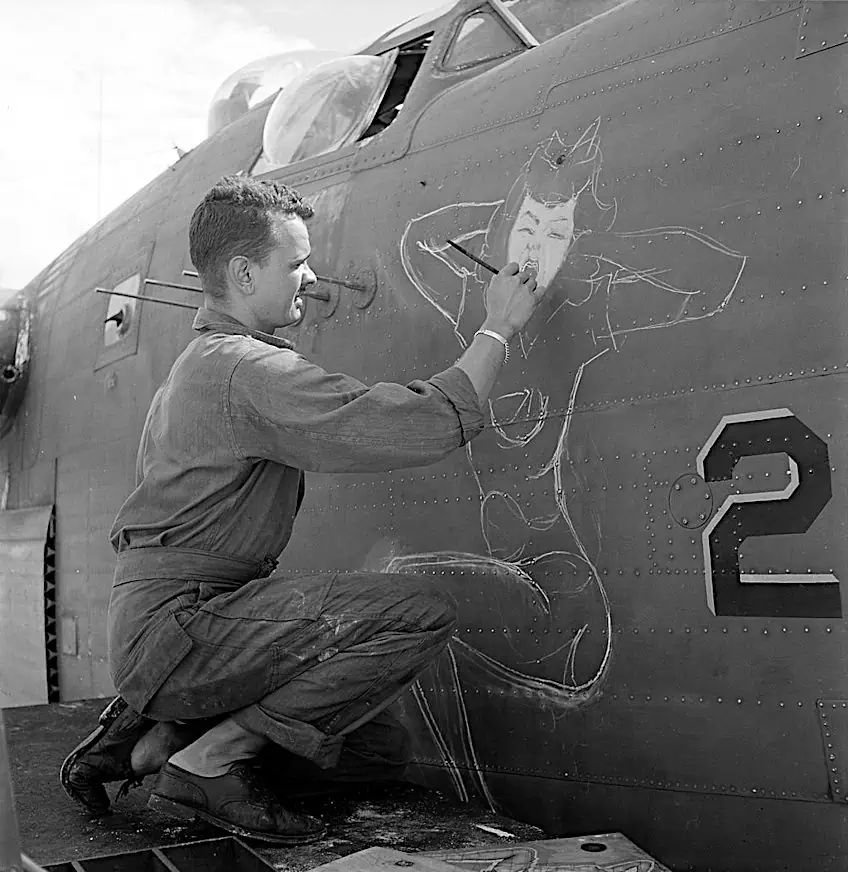
The personalization of aircraft first emerged among German, Italian, and French pilots. One of the most famous examples of early nose art was the red-colored aircraft flown by Baron Manfred von Richthofen, which earned him the nickname “the Red Baron”. Baron Manfred von Richthofen was a German pilot who was so highly praised that he was considered to be the “ace-of-aces” for dog fights during the First World War.
Aviation art during World War II was significant to pilots and military personnel for many reasons. Aside from boosting morale among pilots and crew, it also helped establish a sense of identity and camaraderie while providing room for personal expression.
A few historical examples of nose art include the B-17 bomber plane tagged with “Memphis Belle” and featured a pin-up woman, as well as the many P-40 fighter planes tagged with the label “the Flying Tigers” and decorated with tiger motifs. Below, we will dive into the details of the origins of nose art as well as its most popular symbols and imagery.
Tracing the Origins of WW2 Nose Art
WW2 nose art finds its roots in World War I as a functional visual marker to help pilots and military personnel distinguish their own planes from enemy planes. The kind of imagery used in World War I in nose art was formal and simple and stuck to the national symbols and colors, which became icons of national identity. Paintings of these symbols were made on the fuselages and tails of the planes and were accompanied by other markings and numbers that reflected a pilot’s number of kills or missions.
Nose art took shape as a form of differentiation for the pilot and crew of the aircraft and type of plane, and was a common way to honor the success of individual pilots or bomber crews.
Although the art form has its roots in World War I, its golden age is attributed to the Second World War, where nose art was prevalent and crews spent significant time personalizing their planes. The American and Allied forces were famous for groups such as the Memphis Belle and the Flying Tigers, who gained widespread recognition throughout the war.

Nose art became a creative practice and tradition for pilots and crew members to reflect their sense of camaraderie and relay their individuality. From humorous images to cartoon characters and patriotic symbols, nose art was a form of bonding for many. With the end of the war, nose art continued to remain a significant aspect of military aviation with its legacy remembered and celebrated by artists and enthusiasts who appreciate the historical value of nose art.
Pinup Nose Art
World War II was also a time when pin-up posters and seductive photographs of women were used to boost the morale of pilots and military personnel. The inclusion of women portrayed as seductive, erotic, and even exoticized is one of the critiques of nose art during the war that stems from patriarchal cultures of the time. Pinup nose art included images and illustrations of women portrayed as attractive, glamorous, and seductive in the paintings of war aircraft. Pinup nose art was especially popular among the allied forces and was a form of inspiration for men who were familiar with the pinup culture found in magazines and calendars, and was therefore a reminder of the nostalgia, beauty, and humor of home.
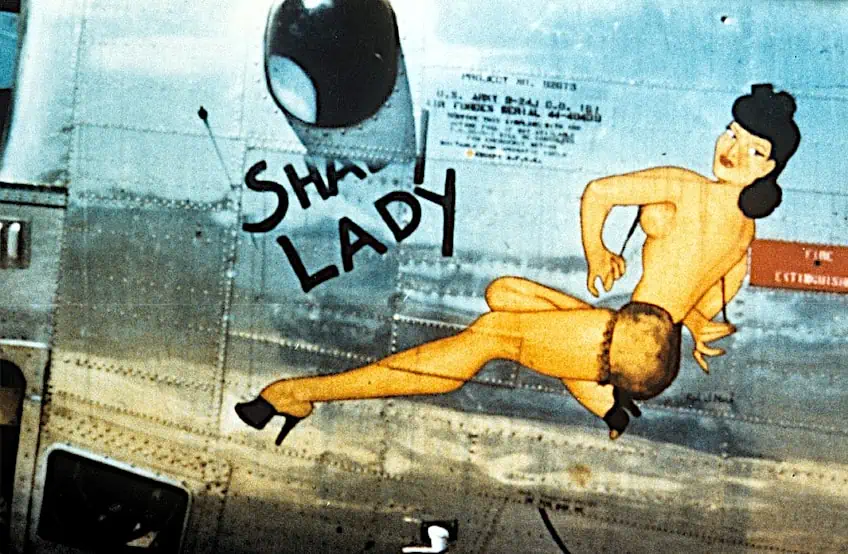
Nose art painters were commissioned to create eye-catching images and designs on the noses of the planes to symbolize the era and add a personal touch to the aircraft. These pinup nose art works also included texts and slogans to reflect the spirit of the time and often referred to characters and shows from 1940s American popular culture.
Many styles emerged in pinup nose art and ranged from realistic designs to cartoon graphics and detailed illustrations. Caricatures are also featured in pinup nose art to exaggerate certain features of women.
One of the most well-known fighter pilot groups, the Flying Tigers, operated from China and used pinup imagery on P-40 Warhawk aircraft. Popular names such as “Old Exterminator”, “Miss-Hap”, and “Bad Angel”, are featured alongside the pinup images. Pilots such as Lieutenant Colonel Richard “Dick” Winters, who commanded the Easy Company of the 506th Parachute Infantry Regiment had a pinup artwork on the nose of his C-47 transport plane. The plane also bore the text “That’s All, Brother” and is recognized as one of the most famous examples of pinup art in nose art used by famous pilots. The renowned pilot Captain Joseph “Joe” Foss, a Marine Corps fighter ace, flew a Grumman F4F Wildcat called Marion, which featured a pinup girl named Marion on the plane’s fuselage.

Iconic Imagery in Bomber Artwork
Nose art was also called bomber art and enabled pilots to stand out from each other through unique motifs, symbols, mascots, and coats of arms. These images also helped pinpoint pilots with aristocratic origins and were visual markers of the pilots’ tactics, methods of fighting, and sense of uniformity. One of Italy’s best World War I fighters, Count Francesco Baracca, championed his signature emblem, the cavallino rampante (black horse), which later inspired the famed Enzo Ferrari.
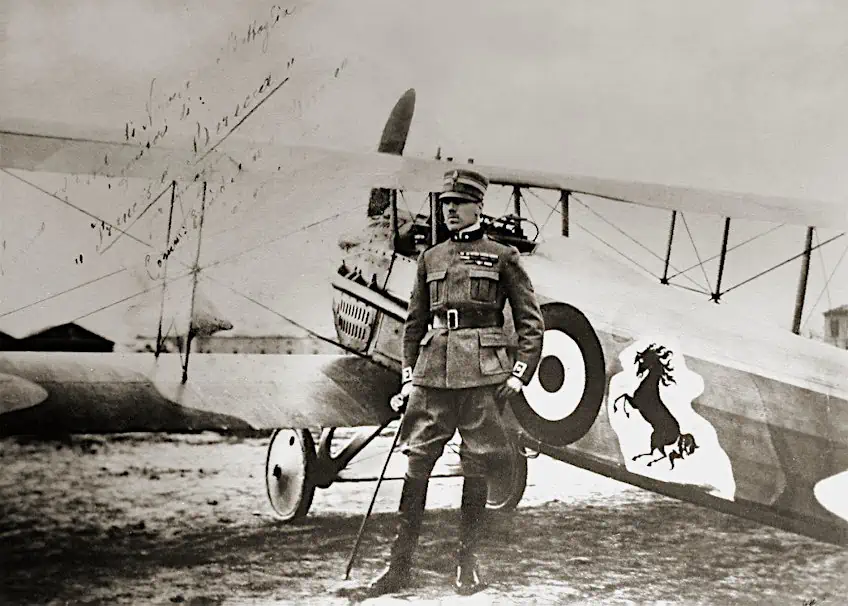
Bomber artwork in the 1940s featured a range of iconic images, which became symbols of the era. In addition to pin up girls, bomber art also reflected patriotic symbols such as national flags, eagles, and slogans to convey a sense of national pride and unity. Characters from popular culture such as Disney’s Donald Duck and Warner Bros.’ Bugs Bunny were lighthearted icons of nose art that disrupted the seriousness of the war. Motifs with tigers, sharks, and dragons were used on aircraft to signify strength and power while other images included illustrations of bombs, provocative phrases, and playing cards to boost morale.

The purpose of such imagery was also intended to enhance the physical features of planes and was one of the reasons why German pilots invented the most distinctive styles of differentiation. Images with intimidating features and icons included the menacing mouths of a shark or tiger painted on the nose and face of the plane. These paintings transformed the architecture of the aircraft such that the plane and animal became one.
The first shark mouth-painted plane debuted on the German Roland C.II. aircraft called Walfisch, translated in English as the “Whale”.
The Symbolism Behind Aviation Nose Art
Aviation nose art during World War II displayed many symbols, which mirrored the values, desires, and individual experiences of servicemen. Nose art evolved into a visual language and form of communicating the emotions of a nation in the context of wartime aviation. Some of the unique symbols found in nose art include beauty encompassed by attractive pinup women, which also served as motivation for the crew. National symbols such as national flags, colors, eagles, patriotic phrases, and statements reinforced personnel’s dedication to the war and represented the defense of one’s country.

Fierce animals such as sharks, tigers, and dragons conveyed a sense of invincibility and symbolized the ferocious nature of the plane and the pilot, which instilled fear in one’s enemy. Comic book and cartoon characters also symbolized resilience and added a sense of humor to the harsh realities of the day while caricatures and personalized names provided pilots with ownership, recognition, and responsibility for connection, unity, and identity within the crew.
Key Influences in Wartime Plane Art
Among the key influences in wartime plane art include different themes, styles, and visual aesthetics promoted in popular culture, which was common in nose art. Popular culture images from comic books, cartoons, Hollywood movies, and pinup celebrities provided a sense of glamor and humor to the nose art. Folklore and mythology also influenced nose art imagery through the use of images of legendary heroes, mythical creatures, and folklore, which shaped a significant portion of nose art.
Mythical creatures like the phoenix and the dragon were common elements in nose art as well as folklore images such as knights and Valkyrie also added an element of valor and mysticism.
The role of patriotism and propaganda was perhaps the main driving force behind nose art and its popularization, which leveraged national symbols and slogans to market determination in the face of an enemy and encouraged pilots and civilians to support the war. Nose art was a form of identity within military units, each of which had its unique background and history with traditional symbols that reflected each unit’s sense of belonging. Military unit identity was among the top driving forces behind the creation of nose art itself, which gave rise to increased personalization, and the formation of distinct imagery.
Famous Nose Art Painters
Many artists worked on commissioned plane paintings during the war and helped shape the visual landscape of aviation art. Among the famous artists are a few well-known names with many other painters who remained anonymous during the era. Below, we will introduce you to a few notable artists who specialized in nose art.
George Petty (1894 – 1975)
| Name | George Brown Petty IV |
| Date of Birth | 27 April 1894 |
| Date of Death | 21 July 1975 |
| Nationality | American |
| Associated Movements, Themes, and Styles | Nose art, pinup art, and war art |
| Mediums | Painting and illustration |
| Famous Artworks |
|
George Petty was a well-known name in the pinup painting and illustration avenue of American nose art whose seductive and playful illustrations of women were featured on World War II planes. Petty’s illustrations also featured on many bomber artworks and was best known for his distinct style, published in Esquire magazine. His illustrations were named the “Petty Girls” and featured coquette-styled shapely women whose elongated legs were printed across magazines and calendars. Petty studied at the Art Institute of Chicago and later trained at the Académie Julian in Paris. Petty’s ideal character of a woman was incredibly popular and featured in an MGM Studios musical in 1950.

Alberto Vargas (1896 – 1982)
| Name | Joaquin Alberto Vargas y Chávez |
| Date of Birth | 9 February 1896 |
| Date of Death | 30 December 1982 |
| Nationality | Peruvian-American |
| Associated Movements, Themes, and Styles | War art, aviation art, nose art, figurative art, pinup art, erotic art, and portraiture |
| Mediums | Painting and illustration |
| Famous Artworks |
|
Alberto Vargas was among the leading pinup artists of the 1940s who created many nude illustrations of women that were incorporated into nose art on warplanes. Vargas’ artwork promoted the idealized 1940s feminine figure, depicted in many warcraft artworks. The Peruvian-American artist studied in Europe before relocating to the United States in World War I.
Vargas was influenced by the French magazine La Vie Parisienne and worked for many Hollywood studios before his breakthrough poster produced for a film called The Sin of Nora Moran in 1933.
The poster was thereafter known as one of the greatest posters ever made in film and featured the near-naked Austrian-American actress Zita Johann. Vargas’ most famous work was published in Esquire magazine in the 1940s and was dubbed the Vargas’ Girls, of which he produced around 180 paintings.
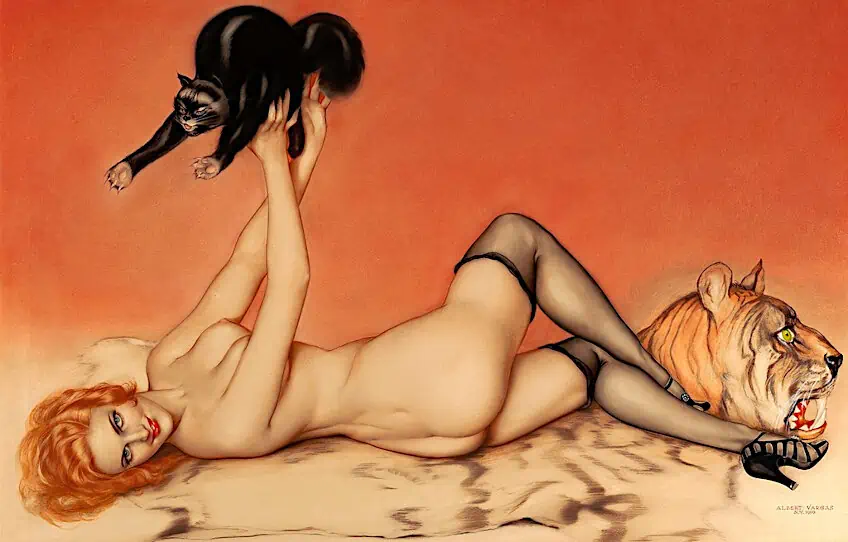
Phil Brinkman (1916 – 2000)
| Name | Phillip S. Brinkman |
| Date of Birth | 1916 |
| Date of Death | 2000 |
| Nationality | American |
| Associated Movements, Themes, and Styles | Nose art, World War II, zodiac signs, animal illustration, commercial illustration, and Modern art |
| Mediums | Painting, drawing, and illustration |
| Famous Artworks |
|
Phil Brinkman was among the best nose art painters of the war whose intricate paintings and designs of patriotic symbols and characters became iconic images in the war. The American painter created many unique designs and was best known for his zodiac sign-inspired imagery. Brinkman joined the special services in the Air Corps and was assigned as a draftsman. His first projects involved lettering and base signage and he was later stationed in Arizona, where he executed his first mural at the Service Men’s Club. His mural portrayed a history of aviation and included the fall of Icarus and many pioneers in aviation, which later became an education aid.
Brinkman’s work on the fighting zodiac paintings was created for the B-24 planes in collaboration with Winfred “Jip” Howell, who was the commander of the 834th Bomb Squadron.
By 1944, Brinkman moved to the Army Air Force Station 174 in Suffolk where he created nose art and murals at the army base. None of his original works from this period survived, but many remain preserved in photographs.
Don Allen (1919 – 2013)
| Name | Don Allen |
| Date of Birth | 14 October 1919 |
| Date of Death | 15 August 2013 |
| Nationality | American |
| Associated Movements, Themes, and Styles | Nose art, World War II, portraiture, and cartoon illustration |
| Mediums | Painting and illustration |
| Famous Artworks |
|
Nose artist Don Allen was a prolific painter of warplanes in World War II who was a crew chief on the Fourth Fighter Group, 334th Fighter Squadron based in England. Allen used nose painting as a creative outlet from his daily duties during the war to create many unique pieces that are currently recognized as treasures of nose art. Allen created many paintings for his squadron’s P-47 and P-51 planes and leveraged his experience as a commercial illustrator to produce many vibrant and catchy illustrations. His style was playful, humorous, and customized to the pilot he painted for. Many of the aircraft that he painted became famous aces in the war, which were then smelted and sold for scrap after the war ended.
The original works may have perished, but Allen himself recreated his work for the AMC Museum in Delaware, which showcased his best works from World War II.
There is no other genre in the history of art that relates so closely with World War II and the many cultural influences of the time like nose art. These famous nose art painters captured the essence of the war and the many emotions around it through their quirky, vibrant, and Pop-styled artworks. Nose art is historically significant for its impact on instilling national identity in the servicemen and servicewomen of the 1940s and stands as a testament to the human experience of war, bloodshed, bravery, and propaganda.
The golden age of aviation art during World War II holds tremendous significance on the interpretation and role of popular culture in wartime art and its influence on Modern art. Nose art produced during the war captured the spirit, emotion, and experience of the war that conveyed the hope, fear, and aspirations of the pilots involved.
Frequently Asked Questions
What Imagery Featured in WW2 Nose Art?
There were numerous icons and symbols featured in WW2 nose art, including images of pin-up girls, animals, national symbols, cartoon characters, intimidating imagery, and personalized messages and texts. Characters such as Bugs Bunny, Donald Duck, and Betty Boop were featured in plane art during the war, along with many national symbols alluding to unity, national pride, national flags, and patriotism.
Why Did Pilots Paint Their Planes in WW2?
In World War II, many pilots painted their planes to add a sense of personalization to the aircraft that would carry them into and out of the war. World War II nose art was crucial to pilots in establishing a sense of morale and visual identity amid challenging times. They served as a form of communication and instilled a sense of familiarity for the crew.
When Was the Golden Age of Aircraft Nose Art?
Aviation art thrived in the early and mid-1940s, and was identified as the golden age of aircraft nose art. The artistic developments of this period were based on World War II and influenced aviation art after the war. The art form reached its peak at the end of the war, since many planes that were deployed played a major role in the war efforts and were considered important symbols of national pride, identity, and struggle.
Jordan Anthony is a Cape Town-based film photographer, curator, and arts writer. She holds a Bachelor of Art in Fine Arts from the University of the Witwatersrand, Johannesburg, where she explored themes like healing, identity, dreams, and intuitive creation in her Contemporary art practice. Jordan has collaborated with various local art institutions, including the KZNSA Gallery in Durban, the Turbine Art Fair, and the Wits Art Museum. Her photography focuses on abstract color manipulations, portraiture, candid shots, and urban landscapes. She’s intrigued by philosophy, memory, and esotericism, drawing inspiration from Surrealism, Fluxus, and ancient civilizations, as well as childhood influences and found objects. Jordan is working for artfilemagazine since 2022 and writes blog posts about art history and photography.
Learn more about Jordan Anthony and about us.
Cite this Article
Jordan, Anthony, “WW2 Nose Art – The History of Military Aviation Art.” artfilemagazine – Your Online Art Source. October 24, 2023. URL: https://artfilemagazine.com/ww2-nose-art/
Anthony, J. (2023, 24 October). WW2 Nose Art – The History of Military Aviation Art. artfilemagazine – Your Online Art Source. https://artfilemagazine.com/ww2-nose-art/
Anthony, Jordan. “WW2 Nose Art – The History of Military Aviation Art.” artfilemagazine – Your Online Art Source, October 24, 2023. https://artfilemagazine.com/ww2-nose-art/.


